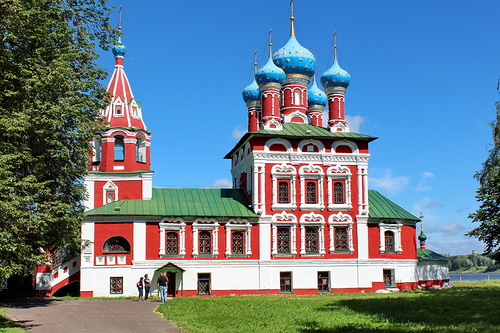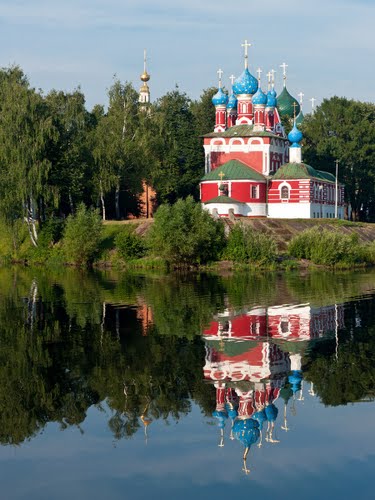

 Church of Prince Dmitry "on the Blood" is the most
famous temple in Uglich. It stands on the banks of confluence of the
Volga River and Stone Creek. Church of Prince Dmitry "on the Blood" was constructed on a site of
unexpected death of prince Dmitry on May 15, 1591. Death
of son of Ivan the Terrible is still unexplained. The official story
was that he was playing with his friends when epileptic seizure
cause his fall. Prince Dmitry fell on the ground and severed his
artery that lead to quick death. Other people claimed that he was
murdered by two assassins who were sent by Boris Godunov, close
associate of Ivan the Terrible who took Russian throne after the
death of Dmitry, the last in the male line of Rurik dynasty. What
ever might the true cause of his death is still unknown, but
legitimacy of Boris Godunov was immediately questions by the public.
It lead to a turmoil of Civil War. Polish and Lithuanians quickly
seized the chance to conquer Russia. They failed, but Russia lost
thousands of lives in the decade that became known as the Troubled
Times in Russian History.
Church of Prince Dmitry "on the Blood" is the most
famous temple in Uglich. It stands on the banks of confluence of the
Volga River and Stone Creek. Church of Prince Dmitry "on the Blood" was constructed on a site of
unexpected death of prince Dmitry on May 15, 1591. Death
of son of Ivan the Terrible is still unexplained. The official story
was that he was playing with his friends when epileptic seizure
cause his fall. Prince Dmitry fell on the ground and severed his
artery that lead to quick death. Other people claimed that he was
murdered by two assassins who were sent by Boris Godunov, close
associate of Ivan the Terrible who took Russian throne after the
death of Dmitry, the last in the male line of Rurik dynasty. What
ever might the true cause of his death is still unknown, but
legitimacy of Boris Godunov was immediately questions by the public.
It lead to a turmoil of Civil War. Polish and Lithuanians quickly
seized the chance to conquer Russia. They failed, but Russia lost
thousands of lives in the decade that became known as the Troubled
Times in Russian History.
Soon after death of Dmitry a small wooden chapel was erected on this tragic place, but it was burned down by the invading Polish (Roman Catholic) soldiers. After new dynasty of Romanoff established peace in the country a new wooden church was built on this site in 1630 to honor memory of a dead prince. Later a winter church of Archangel Michael was added. Russian tsar Alexey (Alexei) Mikhailovich visited the Church of Prince Dmitry in 1633 and entered the altar where tomb of prince was located.
In 1692 stone version of the church was constructed. The upper church was dedicated to Prince Dmitry who was recognized as a saint by Russian Orthodox Church, while the lower part was dedicated to Archangel Michael. Iconostasis of the main church was added in 1866. Today the church is mostly a museum. Services are held occasionally, but they are rare. The remains of Prince Dmitry were removed and transported to Moscow.
History
A wooden chapel was cut down on the
site of the murder of Tsarevich Dimitri in the early years of the
17th century. In 1630, it was replaced by a wooden church. The
construction of the present church began in 1681-1682. The
construction was carried out with royal donations, and in 1690 it
was patronized by Princess Anna Vasilievna Cherkasskaya, a relative
of Queen Maria Nagoya. In 1692 the stone church was completed and
consecrated. The temple is located on the banks of the Volga in the
northeastern part of the Kremlin.
Legend has it that on every
anniversary of the death of the tsarevich blood appeared through the
sand. The first king of the Romanov dynasty, Mikhail Fedorovich,
allegedly could also share the fate of Tsarevich Dimitri, but he was
saved by Ivan Susanin, so he ordered to build a stone church at his
own expense. The Romanovs, including Peter I, supported the cult of
Demetrius and gave it a state scale.
Architecture
A small
building "by a ship" consists of an elongated columnless quadrangle
with a decorative five domes, a refectory, a porch (a
Yaroslavl-style porch on creeping arches) and a low hipped bell
tower. The building is decorated in an elegant manner of the late
17th century. On the blood-red surface of the walls (the color of
spilled blood), snow-white decorative details stand out - platbands,
half-columns, cornices. The southern facade of the church is well
preserved, and on the north side in the 19th century a side-chapel
was built, which does not fit well with the architecture of the main
building.
Painting and interior decoration
The church has
preserved paintings from the second half of the 18th century, which
depict the death of Tsarevich Dmitry, as well as the massacre of the
murderers by the crowd. It is assumed that they were made by the
artel of the Moscow contractor Sapozhnikov in 1772.
The
murals in the refectory are dedicated to the biblical story about
the creation of the world, Adam and Eve, their fall and expulsion
from paradise. They were made by the master Peter Khlebnikov from
the Borisoglebsk settlements in 1788 and represent a vivid example
of the introduction of secular tastes into church painting
(voluminous and realistic nude figures of Adam and Eve).
The
clearing and strengthening of the wall paintings were carried out by
the Yaroslavl Scientific Restoration Workshop in 1971-1976. The
temple belongs to the local museum, admission is paid. The famous
exiled alarm bell is on display here.